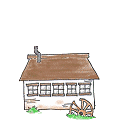posted 10 years ago
Hello Morgan !
I myself spent a lot of time and energy trying to find the optimal swale and interswale size. Eventually, convenience considerations (rather than theoretical 'optimal size') were the ones that determined the final configuration. Luckily my swales turned out just fine and have been working well so far.
My soil is heavy clay, and in rainy periods or during snow melt I have quite a bit of surface runoff on my 0.55 hectare (100x55 metre) plot so I assumed that putting in more - rather than fewer - swales would result in better hydration of the soil, and less surface runoff making it to the bottom 1/3 of the plot, where the house was going to be.
Having said that, I also wanted to have sufficient space in the interval between the swales to be able to put in vegetable gardens and other herbaceous systems.
So I marked out 4 swales at intervals of 15...20 metres. The lowermost swale was marked out about 20 metres above the site of the future house. That took care of the breadth of the interval. But on the day when the man with the excavator showed up, I was still undecided as to the width and depth of the swale itself.
The 'convenience considerations' that I mentioned above were the size of the hoe and the operator's preferred technique (he only brought one hoe with him - I don't recall the size - and it would have meant a half a day's delay if I had decided I needed a larger / differently shaped one). The man dug the swale with the hoe tilted at about 45 degrees. The resulting swale was v-shaped, with a width of about 70 cm at the top, and a depth of about 50 cm. I believe that's a relatively narrow & steep shape, which apparently is suitable for clay soils. If my soil had been of the looser/ sandier type, I may have asked the operator to change his technique and/or hoe so as to obtain a wider / flatter swale. Narrow & steep would not be very stable in sandy soil, I believe - in looser soil I would have kept a depth of up to 50 cm and would have widened the swale to up to 100 cm at the top, with a rather flat bottom.
As for wood chip / other mulch in the swale... I'm sure the mulch would do wonders for the microbiology of the soil in & around the swale. And with a woodchip-filled swale you would probably find it easier to manage the herbaceous vegetation growing inside the swale and the inner slope of the berm. (Mowing the inside of my swales is a real pain in the neck, especially on the side of the berm, where the slope is deeper & steeper.)
However,... I find it very exciting every time I see the swale fill up with water. Whenever that happens, I have standing water for up to a week, during which time the whole feel of the place changes... And this standing water offers you further options - for instance, I intend to divert the (excess) water from my swales into an underground cistern and/or a small seasonal pond.
That's all from me, I hope it helps !
L_


